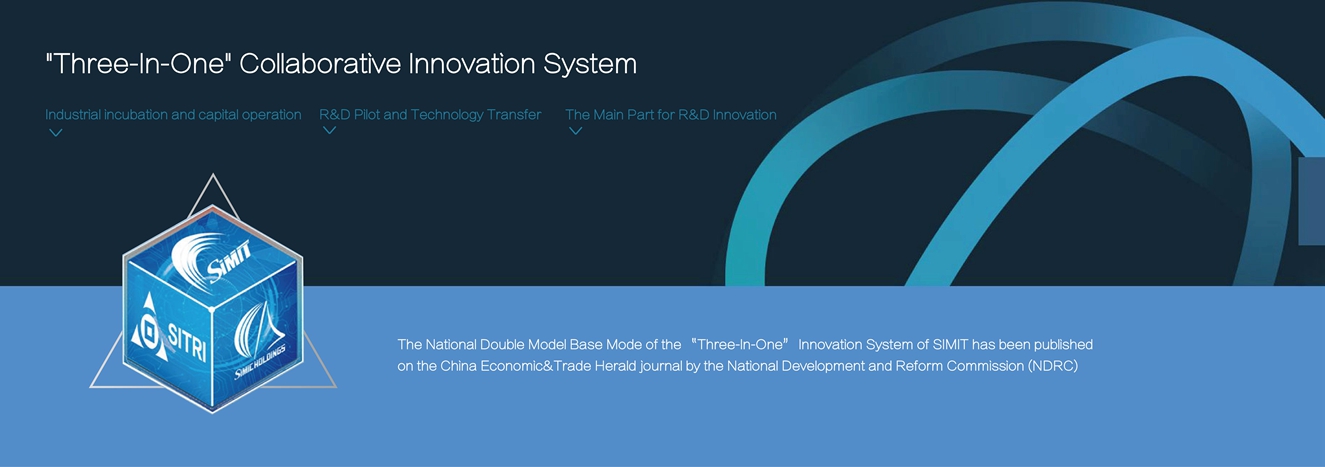SIMIT History
Shanghai Institute of Microsystem and Information Technology (SIMIT), Chinese Academy of Sciences (CAS), formerly known as Shanghai Institute of Metallurgy, was one of the earliest engineering research institute of Academia Sinica founded in 1928. It was named as Engineering Laboratory, CAS and Institute of Metallurgy and Ceramics, CAS. Since August 2001, the name was changed to SIMIT according to its research fields and objectives.
Achievements
During the past 90 years, SIMIT always focuses on national strategic needs, adjusting the layout of its scientific research, and played a leading role in the national economic construction. After the 1960s, SIMIT was again the first entity to have established the ultra-pure metal and III-V compound semiconductor materials research base, and developed the microelectronics and integrated circuit manufacturing technology in China. In collaboration with the industry sector, SIMIT developed micro-electronic devices like the first industrial worthy PN Junction Isolation integrated circuit, ECL high-speed circuit, and the first domestic 8-bit and 16-bit microprocessors. At the same time, considerable progress was made in some exploratory, original creation projects as well, laying a solid foundation for future development.
In the ten years of the knowledge innovation program, SIMIT successfully launched Chuangxin No1’s -01, 02 and 03 satellites and "Shenzhou-VII" companion satellite. It quickly become an important base for research and development of micro satellites in China. SIMIT implemented the Shanghai World Expo Intrusion Prevention Sensor Network, Pudong Airport Intrusion Prevention System, Taihu Lake Water Quality Monitoring Sensor Network, South-to-North Water Diversion Middle Route Security System and other Internet of Things application demonstration projects. We led the development of Internet of Things core technology, and promoted it as a national strategic emerging industry. We developed broadband wireless communication systems with independent intellectual property rights. It was deployed for Wenchuan and Yushu earthquake relief, Shanghai World Expo and other major events. Our broadband wireless communication system played an invaluable role in the earthquake relief work, social stability, public safety and security, digital city and other areas. We created Shanghai Simgui Technology Co Ltd, the first and only world-class advanced SOI materials manufacturer in China. Simgui’s product filled the gaps for domestic SOI material needs and its product has been used in key state projects.
During the "Twelfth Five-Year Plan" period, as the first Technical General Unit with the system level tasks of CAS, SIMIT made breakthroughs in the multi-functional compounding sensors and related key technologies. Special broadband wireless sensor network system solutions were confirmed, related unit large-scale deployments were realized, and narrowband to broadband communication system transitions were achieved. SIMIT successfully developed the first domestic large-scale high-reliability dedicated integrated circuit ASIC chip based on 0.13um SOI process. The chip was used in the Beidou navigational satellite and other key national projects. It helped to lay a solid foundation for the self-sustained designing and manufacturing of spacecraft core components in China. With the support of superconducting single-photon detector (SNSPD) from SIMIT, Academician PAN Jianwei of University of Science and Technology of China (USTC) has, for the first time in the world, implemented a hacker-proof 200 km measurement-device-independent quantum encryption key distribution. This remarkable achievement was selected in the Top Ten Scientific and Technological Progress in 2014 by a group of academicians from CAS and the Chinese Academy of Engineering (CAE). Ultra-high g acceleration sensor was one of critical components for some of the country’s strategic equipment. The ability to make such a sensor weakens the power of an international embargo. We launched and established a MEMS technology industrialization platform known as Shanghai IndustrialμTechnology Research Institute (SITRI). It is now listed by the Shanghai government as part of the "the beams and pillars of a house" of Shanghai’s Globally Influential Technological Innovation Center.
Since the founding of the People’s Republic of China, SIMIT has been awarded 48 national science and technology awards and 351 provincial and ministerial awards. These awards include: the Grand Prize of the National Science and Technology Progress Award, given for "Type A separation membrane" technology; and two separate First Prize of the National Science and Technology Progress Awards given for "High-speed, ultra-high-speed two-stage digital integrated circuit" and "High-end silicon-based SOI material research, development and industrialization."
Organization
There are three national level key laboratories in SIMIT: Transducer technology, functional materials for informatics, microsystem technology; two CAS key laboratories: wireless sensor network and communications, terahertz solid-state; besides, there is a Center for Excellence in Superconducting Electronics.
There are all together seven laboratories (wireless sensor network, functional materials for informatics, terahertz solid-state technology, broadband wireless technology, new energy, superconductor, and bio-vision system) and six affiliated groups in Nanjing, Hangzhou, Jiaxing, Nantong. SIMIT also has joint laboratories with Juelich Research Center, Helmholtz Association,Collaborative Innovation Center for High-Reliability Components with Shanghai Engineering Center for Microsatellites of CAS, and Joint Laboratory on Superconducting Quantum Devices and Quantum Information with University of Science and Technology of China.
Talented Persons
Throughout the years, we have built a team with members who are highly educated and high achievers in their respective fields. Here is a short list of people who passed the rigorous review process of talent selection programs:
CAS Academicians: 2
US Academy of Science Foreign Fellow: 1
The national “Million Talent Project” talents: 5
The “National Outstanding Young Science Fund” winners: 4
The “National Excellent Young Science Fund” winner: 1
The “National Fund Commission for Innovation” group winner: 1
The “10K Talent Plan” youth top talent: 1
The Bureau of Foreign Experts-CAS Oversea Innovation Group: 1
The CAS “Hundred Talent Plan” talents: 21
The Leaders of Science and Technology in Shanghai: 9
SIMIT is one of the first institutes approved by Academic Degrees Committee of the State Council to award master and doctoral degrees:
First grade doctoral/master students unit: electronic science and technology (0809), information and communication engineering
Second grade doctoral/master students unit: materials physics and chemistry
First grade doctoral research station: electronic science and technology, materials science and engineering
There are 445 postgraduates in SIMIT, among which 240 master candidate, 215 doctoral candidate, and 50 in post-doctoral research center.
Objective
Facing the 13th Five-Year Plan, SIMIT, under the guidance of CAS’s principle of “Focus efforts on the frontiers of science, national needs and the economy”, leverage our strengths in the Electronic Science & Technology and the Information & Communication Engineering major disciplines to promote our ability for original creation and innovation, to achieve greater success in research and development. Through overcoming key and technical challenges in the areas of intelligent sensing microsystems, superconductor device and circuits and advanced silicon-based material, we can march forward with innovations and their wider adoptions. Our goal is to become dominant in the area of information, network and communications, and become a national “Four First-Class” research institute, as well as make China an innovative country with science and technology power.

